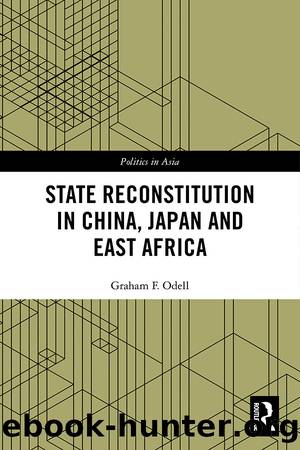State Reconstitution in China, Japan and East Africa by Graham F Odell

Author:Graham F Odell [Odell, Graham F]
Language: eng
Format: epub
Tags: Comparative Politics, Political Science, World, Asian, General
ISBN: 9780429340970
Google: Ge-IzQEACAAJ
Goodreads: 53369790
Publisher: Routledge
Published: 2020-01-15T14:04:07+00:00
Structural conditions of Sengoku Japan
We now turn to the second principal case of this study, Sengoku Japan, which began in 1477 and ended in 1615. Before discussing how the three necessary structural conditions were manifest, I present a brief history of the case.
Prior to the Sengoku Era, the previous state was the Ashikaga Shogunate, which, following the deadly internal conflict known as the Onin War (1467â1477), quickly lost nearly all control over the country and was abandoned by the countryâs political elites. The former central government came to control only the capital city of Kyoto and its environs. Because of its weak regional support bases and close ties to the Shogunate, the shugo (Japanâs regional elites at the time) saw their authority collapsed shortly after the state itself fell apart. What followed was a period of over a hundred years in which the islands of Japan were wracked by internal disunity and increasingly intense and frequent warfare between newly emergent samurai regional elites known as the daimyo, who were mostly distinct from the old shugo families.
Sengoku Japan was characterized not just by political fragmentation and endemic warfare; it also featured a diversity of emergent political forms. In particular, aside from the samurai-controlled territorial units called domains, two types of autonomous political communities arose in the institutional flux of this era. The first such type, the horizontal village federation, became a prominent feature of the political landscape by the early 1500s. As the Ashikaga Shogunate and the socioeconomic order upon which it was based decayed over the course of the 1400s, village communities responded by asserting autonomy over a number of functional areas (Nagahara 1977: 112â117). Some village communities, led by local military elites, managed to form federations for collective defense which were non-hierarchical in their organization (Davis 1974: 243; Tsang 2010). One of the first such federations was established in the central province of Yamashiro in 1485, in the midst of the collapse of shugo power (Davis 1974).2 Although this federation only lasted for seven years, it did manage to appoint a rotating provincial leader and control basic economic institutions. Future federations, such as the Ikko Ikki in Kaga province, lasted much longer and in fact proved to be major forces resisting the state reconstitution projects of the unifiers of the latter sixteenth century. Many other village federations were established in most of the central provinces of Japan, making these institutional arrangements a common feature of Sengoku Japan (Davis 1974: 243). This first example of non-state power, then, seems to have been appealing to a number of segments of the population.
The second type of new, autonomous political arrangement, the temple association, also emerged following the Onin War. The Honganji sect established independent rule in Kaga province in 1488 and had influence elsewhere in the country as well, while the broader Jodo Shinshu religious movement was dominant throughout much of Japan, though centered most strongly in the city of Osaka in central Japan (Tsang 2010: 92). The Honganjiâs influence was largely
Download
This site does not store any files on its server. We only index and link to content provided by other sites. Please contact the content providers to delete copyright contents if any and email us, we'll remove relevant links or contents immediately.
| Anthropology | Archaeology |
| Philosophy | Politics & Government |
| Social Sciences | Sociology |
| Women's Studies |
The Secret History by Donna Tartt(18795)
The Social Justice Warrior Handbook by Lisa De Pasquale(12111)
Thirteen Reasons Why by Jay Asher(8761)
This Is How You Lose Her by Junot Diaz(6737)
Weapons of Math Destruction by Cathy O'Neil(6108)
Zero to One by Peter Thiel(5654)
Beartown by Fredrik Backman(5570)
The Myth of the Strong Leader by Archie Brown(5393)
The Fire Next Time by James Baldwin(5219)
How Democracies Die by Steven Levitsky & Daniel Ziblatt(5105)
Promise Me, Dad by Joe Biden(5061)
Stone's Rules by Roger Stone(5004)
A Higher Loyalty: Truth, Lies, and Leadership by James Comey(4818)
100 Deadly Skills by Clint Emerson(4816)
Rise and Kill First by Ronen Bergman(4672)
Secrecy World by Jake Bernstein(4612)
The David Icke Guide to the Global Conspiracy (and how to end it) by David Icke(4590)
The Farm by Tom Rob Smith(4413)
The Doomsday Machine by Daniel Ellsberg(4389)
